Llanrhystud is a small village on the A487 coastal road between Aberaeron and Aberystwyth, situated nine miles south of Aberystwyth. It is named after the early Christian Welsh saint Rhystud. The men of the Parish who fell during both World Wars are commemorated on the War Memorial tablet which is displayed in the Memorial Hall.
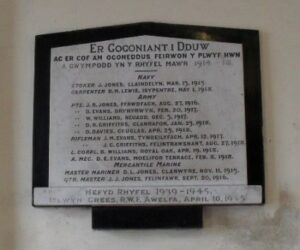
The Great War, 1914-1918
John Evan Clarke, Driver, T4/145740, Royal Army Service Corps. John was the son of William and Sarah Clarke, of Llanrhystud. He enlisted at Aberystwyth into the Army Service Corps. He was posted to the Middle East, and joined the 39th Field Ambulance, Royal Army Medical Corps, which was attached to the 13th (Western) Division. The division had moved into Mesopotamia early in 1916 as part of the force sent in to relieve the siege of Kut. John became ill, and died there on 11 June 1916, aged 27. He is buried in Amara War Cemetery, Iraq. John does not appear to be commemorated locally.
David Davies, Private, 21306, Royal Welsh Fusiliers. David was born at Llanrhystud, the son of Martha Davies, and was the brother of Isaac Thomas Davies, of 3, Edward Terrace, Abertridwr, nr. Cardiff. He enlisted at Llandudno at the outbreak of war into the Royal Welsh Fusiliers, and was posted to the 13th Battalion, Royal Welsh Fusiliers, which became attached to 113 Brigade, 38th (Welsh) Division. On 2 December 1915 the battalion moved to France, and the entire Division moved to the Fleurbaix sector, where it was initiated into trench warfare. During June 1916 the Division marched south to the Somme, and on 7 July 1916 attacked Mametz Wood. The initial attack failed, and it was three days later, on 10 July, that a fresh attack was mounted. After two days of heavy hand to hand fighting within the wood, the Germans withdrew, and the battered Welshmen moved via Hebuterne to Boesinghe, on the Yser Canal, where it remained until launching its attack on Pilckem Ridge on 31 July 1917. The 15th Welsh remained in the line, and also took part in the Battle of Langemarck, before the entire Division was moved to positions near Armentieres over the winter. After the Germans launched their offensive on the Somme on 21 March 1918, the Division was moved back to the Somme, and took up positions north of Albert, around Aveluy Wood. David was wounded soon after, during operations to secure the Bouzincourt Ridge. He died of his wounds on 24 April 1918, aged 31, and is buried at Doullens Communal Cemetery Extension No. 1, France.
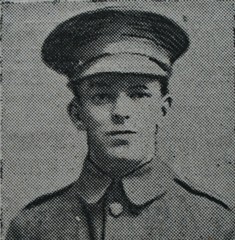
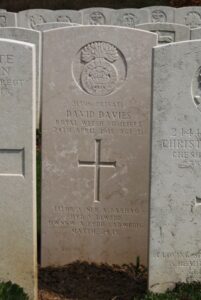
Geraint Davies, MC, Captain, Northumberland Fusiliers. Geraint was the son of Dr. Morgan Davies M.D. F.R.C.S., and Margaret Davies, of Llanrhystud. He had spent most of his life in London, and was commissioned from the London Regiment into the 4th Battalion, Northumberland Fusiliers, which was attached to 149 Brigade, 50th (Northumbrian) Division. The division moved to France 16 April 1915, and took part in the Second Battle of Ypres from April to June 1915. During the summer of 1916 the Division was on the Somme, and fought at the Battle of Flers-Courcelette, the Battle of Morval and the Battle of Le Transloy. After spending a winter on the Somme, it moved north to Arras, where they took part in the Arras Offensive of April 1917. It then moved north and fought at the Second Battle of Passchendaele. By March 1918 the division had been moved to positions near St. Quentin, and was hit by the German Spring Offensive of 21 March 1918, taking part in a gallant rearguard action during the Actions at the Somme Crossings, and then at the Battle of Rosieres. After suffering terrible casualties, the Division moved north to Flanders to rest and rebuild, but in April the Germans launched an attack in Flanders, around the Lys, and the Division took part in the Battle of Estaires, and the Battle of Hazebrouck. Geraint was mortally wounded during this period, and died on 14 April 1918, aged 22. He is buried in Locre Hospice Cemetery, Belgium. Geraint had been awarded the Military Cross at some time during the war, but is not commemorated anywhere locally.
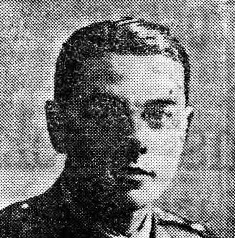
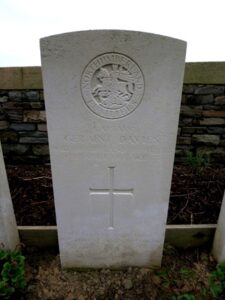
Daniel Evans, Private, 27670, South Wales Borderers. Daniel was the son of John and Eleanor Evans, of Brynyrwyn, Llanrhystud. He enlisted at Brecon into the South Wales Borderers, and was posted to the 4th Battalion, South Wales Borderers, which was in Egypt attached to 40 Brigade, 13th (Western) Division. On 12 February 1916 the Division began to move to Mesopotamia, to strengthen the force being assembled for the relief of the besieged garrison at Kut al Amara. By 27 March, the Division had assembled near Sheikh Saad and came under orders of the Tigris Corps, and then took part in the attempts to relieve Kut. However, after these efforts failed and Kut fell, the British force in the theatre was built up and reorganised. The Division then fought at the Battle of Kut al Amara, then at the capture of the Hai Salient and the capture of Dahra Bend. They took part in the passage of the Diyala, in the pursuit of the enemy towards Baghdad, and part of the Division were the first British troops to enter Baghdad. Daniel was wounded during the move into Baghdad, and died of his wounds on 20 February 1917, aged 24. He is buried at Amara War Cemetery, Iraq.
Daniel Edwin Evans, Air Mechanic 2nd Class, Royal Flying Corps. Daniel was born on 24 April 1892, the son of William and Anne Evans of 4 Meolivor Terrace, Llanrhystud. He served as an Air Mechanic at the Royal Flying Corps School of Technical Training, based at RAF Halton. Daniel died of sickness at the Park Hospital, Reading on 8 February 1918, aged 26. He is buried at Reading Cemetery, Berkshire.
David Morgan Evans, Lance Sergeant, 3520, Army Cyclist Corps. David was born at Llanrhystud in 1891, the son of Thomas and Susannah Evans. He worked as a labourer at Treorchy prior to the war and enlisted at Poplar on 1 September 1914 into the 9th Battalion, Royal Welsh Fusiliers. On 22 January 1915 David was transferred to the XIX Corps, Cyclist Battalion, Army Cyclist Corps, and landed in France on 18 July 1915. David would have fought at the Battle of Loos that year, and on the Somme in 1916. He was killed in action during the follow up of the German withdrawal to the Hindenburg Line on 31 March 1917, aged 25. David was originally buried in the garden of a hose in Villers-Faucon, but his grave was exhumed after the war, and he now lies in Roisel Communal Cemetery Extension, France. David does not appear to be commemorated locally.
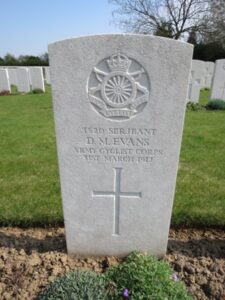
Jenkin Morris Evans, Rifleman, A/200098, King’s Royal Rifle Corps. Jenkin was the son of Jenkin and Margaret Evans, of Tynbaileyfach, Llanrhystud. He enlisted at Bunhill Row, Middlesex into the London Regiment, but upon landing in France was transferred to the 8th Battalion, King’s Royal Rifle Corps, which was attached to 41 Brigade, 14th (Light) Division. In July 1916 the Division moved to the Somme, and fought at the Battle of Delville Wood, and then the Battle of Flers-Courcelette, and in March 1917 followed the German Retreat to the Hindenburg Line. May 1917 saw them at Arras, where they took part in the First Battle of the Scarpe. Jenkin was killed in action at Arras on 12 April 1917. His official age is given as 37 years, but he was in fact 42 years of age. Jenkin is commemorated on the Arras Memorial, France.
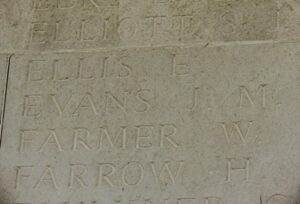
Daniel Robert Griffiths, Private, 291280, Welsh Regiment. Daniel was born in 1891, the son of Margaret Griffiths, of Glanrafon Shop, Llanrhystud. He enlisted at Aberystwyth into the Welsh Regiment, and was posted to France at some time after the Somme offensive in 1916, joining the 16th Battalion, Welsh Regiment, which was known as the Cardiff City battalion, attached to 115 Brigade, 38th (Welsh) Division. Daniel probably served with the Battalion at Ypres, during its attack on Pilckem Ridge on 31 July 1917, and then at the ensuing Battle of Langemarck. He was invalided to England late in 1917, and died at home on 23 January 1918, aged 27. Daniel is buried at Llanrhystud (St. Rhystyd) Churchyard.
James Gernon Griffiths, Rifleman, 303133, London Regiment. James was born at Llanrhystud, the son of David Griffiths. He resided in London prior to the war, and enlisted there into the 1/5th Battalion, London Regiment (London Rifle Brigade). James joined the battalion in France at sometime in 1916, where it was attached to 169 Brigade, 56th (London) Division. The Division fought at the diversionary attack on Gommecourt then at Ginchy, Flers and Morval, where they captured Combles. They wintered on the Somme, and followed the German retreat to the Hindenburg Line in March, 1917 before fighting in the Battle of Arras. They then moved to Ypres, where they fought at Langemarck, then at Cambrai during the Battle there in October 1917, remaining in the area for the winter. The Division were in the Arras sector when the German Spring Offensive was launched on 21 March 1918 and fought at the resulting Battle of Arras. In August they took part in the offensive, at the Battle of Albert. James was killed in action during the advance, on 27 August 1918. He is commemorated on the Vis-En-Artois Memorial, France.
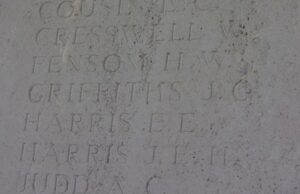
Daniel Lewis Jones, 1st Mate, Mercantile Marine. Daniel was the son of Daniel and Mary Jones (nee Lloyd), of Llanrhystud. He served with the Mercantile Marine, aboard the SS Rhineland, a Liverpool registered cargo steamer. On 11 November 1915, Rhineland was on voyage from the Tees to Nantes with a cargo of steel bars, when she was sunk by a mine from the German submarine UC-3, about six miles off Southwold. Daniel was among 20 men lost that day during the sinking. He was 49 years old, and is commemorated on the Tower Hill Memorial, England.
Jenkins Jones, Able Seaman, Mercantile Marine. Jenkins was the son of David and Margaret Jones, of Felinfawr, Llanrhystud. He served with the Mercantile Marine aboard the SS Etton, a Hull registered cargo ship. On 20 September 1916, Etton was on voyage from Barry to Archangel with a cargo of coal, when she was sunk by a mine which had been laid by the German submarine U-75. Jenkins was the only man lost in the sinking that day. He was 22 years old, and is commemorated on the Tower Hill Memorial, London.
John Jones, Stoker 2nd Class, K/22680, Royal Navy. John was born at Llaindelyn, Llanrhystud on 2 December 1894, the son of Winifred Jones. He served with the Royal Navy aboard the Topaze Class Cruiser, HMS Amethyst. At the outbreak of war, Amethyst was assigned to the Harwich force, and participated in the Battle of Heligoland Blight, before becoming transferred to the 1st Light Cruiser Squadron. She then steamed for the Mediterranean, and took part in the covering operation for the minesweeping effort in the Dardanelles. On 14 March 1915 Amethyst was hit by Turkish field artillery, and suffered 22 men killed, and a further 38 men wounded. John was among the dead. He was 20 years old, and is commemorated on the Portsmouth Naval Memorial, Hampshire.
John Richard Jones, Private, 33260, South Wales Borderers. John was born in 1894, and was raised by his grandmother, Jane Jenkins, at Ffrwdfach, Llanrhystud. He enlisted at Lampeter into the army, and was posted to France early in 1916, joining the 1st Battalion, South Wales Borderers, which was attached to 3 Brigade, 1st Division. John joined the battalion at Maroc, near Loos, and moved with the battalion south to the Somme, arriving at Franvillers on 8 July 1916. The 1st Division moved into Albert, preparatory to taking its place in the front line, moving in past Mametz Wood on 16 July. The Division took part in the Battle of Bazentin Ridge, and at the resulting Battle of Pozieres Ridge. John was killed during fighting at Bazentin-le-Petit village on 27 August 1916, aged 22. He has no known grave, and is commemorated on the Thiepval Memorial, France.
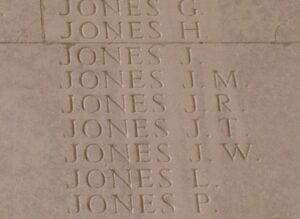
David Morgan Lewis, Greaser, 912866, Royal Navy. David was the Son of David and Mary Lewis, of Isypentre, Llanrhystud. He lived with his wife, Catherine Lewis, at 32, New Road, Llanelli prior to the war, and enlisted into the Royal Navy. David was serving aboard HMMS Blackmorevale, which was a minesweeper, when she struck a German Mine off Montrose on 1 May 1918 and sank. David was killed during the sinking. He was 30 years old, and is commemorated on the Plymouth Naval Memorial, Devon.
David Williams, Lance Corporal, 12021, South Wales Borderers. David was the son of John and Elinor Williams, of Royal Oak, Llanrhystud. He enlisted at Newport into the South Wales Borderers, and was posted to France at sometime after 1916, joining the 1st Battalion, South Wales Borderers, which was attached to 3 Brigade, 1st Division. The Division fought during the Somme Offensive in 1916, and followed the German retreat to the Hindenburg Line in early 1917. It then moved to the Flanders Coast during the summer of 1917. After it had become apparent that the Passchendaele Offensive had bogged down, the Division was recalled to Ypres, where it fought at the Second Battle of Passchendaele. After spending another Winter in Flanders, it was near Estaires when the German Spring Offensive struck. David was wounded during the build up to the German attacks, and died on 19 April 1918, aged 30. David is buried at Pernes British Cemetery, France.
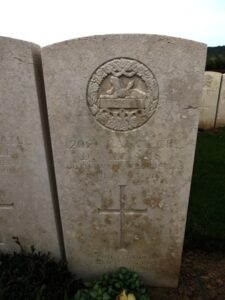
William Williams, Private, 242130, Worcestershire Regiment. William was born at Llanrhystud, and resided at Pontypool prior to the war. He enlisted there into the Monmouthshire Regiment, but was transferred to the 2/8th Battalion, Worcestershire Regiment, which landed in France on 24 May 1916, joining 183 Brigade, 61st (2nd South Midland) Division. The Division moved to France during 21 May 1916, moving to positions at Fromelles. The first major action in which the Division was engaged was the disastrous attack on 19 July 1916 at Fromelles, which was intended to be a division for the main Somme offensive. In March 1917 the Division followed the German withdrawal to the Hindenburg Line. Later that year it fought at the Third Battle of Ypres. The Division then moved south, and took part in the Battle of Cambrai, between 20 November and 7 December 1917. William was killed during the German counter-attack, on 3 December 1917, and is commemorated on the Cambrai Memorial, Louverval, France.
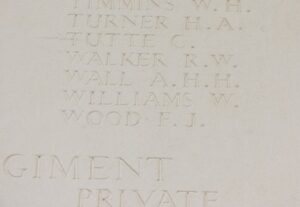
World War Two, 1939-1945
Islwyn Aneurin Crees, Fusilier, 14747419, Royal Welch Fusiliers. Islwyn was the son of Edward Francis and Annie Elizabeth Crees, of Llanrhystud. He served with the 6th Battalion, Royal Welch Fusiliers, which was attached to the 53rd (Welsh) Division. The Division landed on the Normandy beaches at the end of June 1944, and took part in the break-out of the beach-head, fighting in the notorious Bocage. It then took part in the drive through Northern France into occupied Belgium and Holland, towards Germany. Islwyn was killed in Germany on 10 April 1945. He was 19 years old, and is buried in Becklingen War Cemetery, Germany.